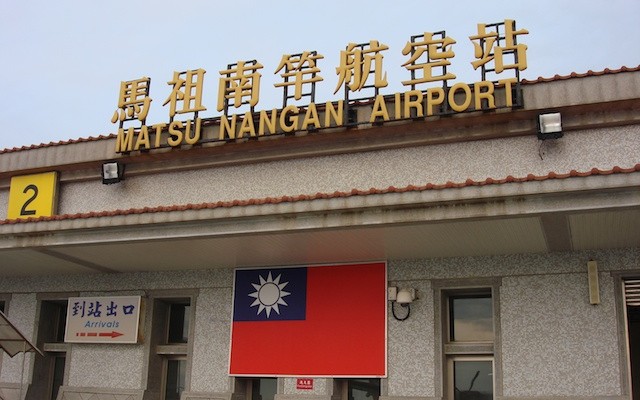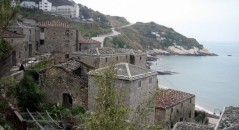
Nangan is the most southerly of the two main islands and the biggest island in the chain. It has the feel of an enormous military base, but then that’s part of the attraction of visiting a “frontier” island.
We decided to fly into Nangan and fly back to Taipei from Beigan, principally because there is more to see in Nankan but we wanted to see both islands, and it worked out well.
The first thing to sort out was transportation (you can find details in this article). As luck would have it, we started chatting with a taxi driver, “Huei-ge” outside the airport who happened to have a car for hire in the car park. The airport chief saw us chatting and came over to tell us that the driver was a good chap, so our decision was made. As it turned out, the car was a repainted taxi which had seen better days, especially the tyres. Still, Matsu Ho!
Huei-ge lived up to his reputation and went to great lengths to help us. He insisted on giving us a free whirlwind tour of the island in his taxi before we got the keys to his car. The whirlwind ended up blowing for hours, but we did have a good feel for the island and the road system, which I suspect was his plan what with giving a couple of foreigners his car. I don’t think this was part of his usual business.
There are essentially only three roads on the island, but it is still surprisingly easy to get lost (although GPS devices work if you have one). Luckily, we seemed to pass Huei-ge every time we were on the road, and frantic hand waving sufficed to keep us on track.
The Nangan Visitor Center is well worth a visit, as with many visitor centers in Taiwan. They have a map and other information in English, including an introductory DVD. I’d recommend starting here and planning where you’d like to visit.
The Beihai Tunnels are a must and next to the Visitor Center. This enormous structure was blasted out of the granite cliffs and cleared by hand when relations with China were somewhat more strained, to allow small ships and landing craft to take shelter. Thankfully they are now open to the public when the tide is low (check with the Visitor Center for opening times that day). Walking round you can almost hear the sounds of ships docking with relieved sailors having made the crossing from Taiwan.
There are nine fishing villages dotted around the island, and most of them contain some examples of the old style architecture mixed in with newer buildings. Fuxing Village (which used to be called Niuqiao Village and no one there seems to know why it was renamed) in particular is worth visiting. If you look carefully, you will find a restaurant in a converted house, which is apparently over 100 years old. The food is very good and the staff very friendly.
When I asked why people moved to Matsu hundreds of years ago, the answers were either, “wealthy fishermen” or “traders”, but no one mentioned pirates until I got back to Taipei. A Matsu born couple now living in Taiwan took one look at the fishing villages and said straight away, “pirates”. I am quite sure that there were fishermen and businessmen, but you can imagine the many coves of fog shrouded Matsu being perfect hideaways for pirates.
Another village worth mentioning is Jinsha (or possibly Tsinsha depending on the map again). This small village was practically deserted when the troops came, but people are slowly moving back. Some of the buildings still lie in ruins (which can make for some great photos), but there is a large amount of regeneration going on. What I really liked about this was that they are preserving the architecture and rebuilding with the same materials. It is pretty unusual to see that anywhere else in Taiwan, and the areas they have already rebuilt are quite charming.
Most of these renovated buildings are becoming “homestays” which I think is another excellent idea. If you have four people in your group, you can have an entire building to yourselves and make it your Matsu home for a very reasonable price. Depending on the success of the casino of course which may well change everything.
Another place that is familiar with most people in Taiwan (actually what most people now associate with Matsu) is Tunnel 88 and the famous grain liquor, kaoliang. You can visit the tunnels (where they store the “old wine” as well as the vats of kaoliang) and the “brewery”. Be prepared though, you will have to sample some of the liquor before you leave, regardless of the time of day (there is no pressure to buy anything, this is just being friendly).
We stayed at Coast of the Dawn Hotel (site in Chinese only). This was really off-season (March) so it was kind of empty, but very comfortable and the rooms had heaters (important with the cold sea air). More crucially for me, there was a great view of the sea and a nice little balcony outside the room where you could sit and enjoy the sound of waves. There is plenty of accommodation though, but if you come during peak season, make sure you book in advance (a few places are listed here in the Accommodation section; choose “Lienchiang County” as the region).
There are plenty of other places to visit, including Iron Fort and tunnels equipped with large guns. The map has everything marked in English, and the official website is packed with useful information.
So after two days and a farewell meal with Huei-ge and his extended family, we set off to Beigan.

